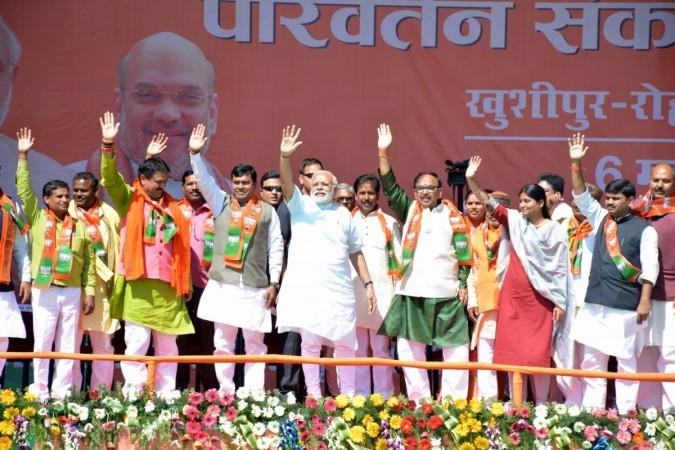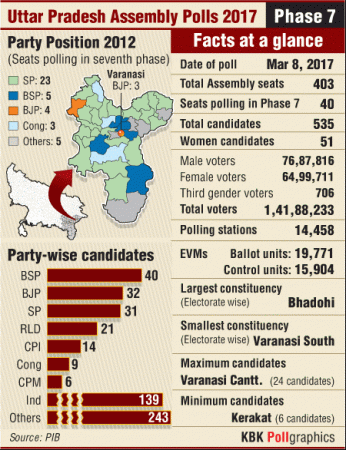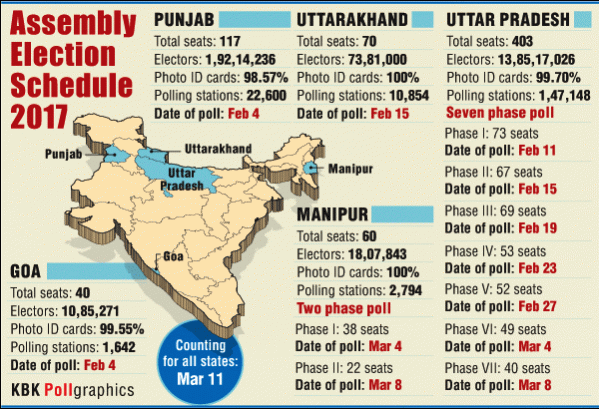
Prime Minister Narendra Modi addressed a rally in his home constituency Varanasi on Sunday, the second in two straight days. The temple town, along with other six districts, goes to polls on Wednesday (March 8). The rallies by Modi and the presence of BJP president Amit Shah in the city for the past 10 days signifies how important the state elections are for the party.
A trader in the city and office-bearer of Varanasi Nagar Udyog Vyapar Mandal told the International Business Times India Edition that the going for the BJP will be a tad tough this time, given the disenchantment among some voters. "Many promises have been made by the BJP for Varanasi, but very little is visible on the ground," he said. As for the business community, he said it was largely supportive of Modi's demonetisation despite the initial impact on earnings.
Campaigning for the 40 Assembly seats that go to polls on Wednesday will end today evening.
Counting of votes for the bitterly-contested Uttar Pradesh Assembly elections 2017 will be taken up on March 11 (Saturday), along with Punjab, Goa, Uttarakhand and Manipur. The results would matter a lot to political parties, but the party to watch out for will be the Bhartiya Janata Party (BJP).
Here, we look at what the election results could throw up in Uttar Pradesh and their fallout on politics, both in the state and at the Centre. It is pertinent to mention here that Uttar Pradesh has a population of about 20 crore (200 million) people, and only five countries of the world are larger than the state from a population viewpoint.
Outcome No. 1
The Samajwadi Party-Congress (SP-Congress) coalition wins a clear majority and forms government.
Implication
The victory will be some consolation for the Congress that has seen its political fortunes dwindle since the 2014 general elections and ended its 10-year reign at the Centre. As for Akhilesh Yadav, he will retain power and get a chance to position the SP as a major player when elections are held in 2019. Consequently, the outcome will weaken the BJP politically and affect the morale of its workers.
A defeat for the BJP would give rise to speculation whether the "Modi magic" is waning in the state after the 2014 performance. The party had won 71 out of the 80 Lok Sabha seats in 2014, enabling it to get a majority of its own in the Lok Sabha, surprising even the most-optimistic analysts.
At the Centre, the political pendulum, so to say, will slightly move to the Opposition in the Lok Sabha where the BJP-led NDA has a dominant majority.
Outcome No. 2
The BJP wins a clear majority, forms government in the state after almost 15 years. The elections were won by the SP in 2002, the Bahujan Samaj Party (GSP) in 2007 and SP in 2012.
Implication
The return from a long hiatus would come at a time when Modi took the boldest of reforms, the decision to ban high-denomination notes as part of ongoing efforts to curb black money. The BJP would claim its victory as an endorsement of the decision.
There could also be a shift in the BJP's narrative from identity politics to one that sees development as an election plank that pays off.
That's not all.
The party will stand to significantly increase its numbers in the Rajya Sabha (RS), as the state sends 31 members to the Upper House. The BJP-led NDA is in a minority in the 245-member RS. The results could also see FDI equity inflows into India looking up after slowing down during the demonetisation months.
FDI equity inflows had slowed down from $6.19 billion in October 2016 to $4.67 billion next month and $3.34 billion in December 2016. FDI equity inflows into India rose 22 per cent during April-December 2016 to $35.84 billion, compared to $29.44 billion in April-December 2015.
Further, foreign investors will take comfort that the verdict would ensure that Modi would stay with his reformist agenda, even initiate more. Stock markets would rally, aided by increased FPI inflows into Indian equities and in the process, strengthen the Indian rupee.

Outcome No. 3
No party wins a clear majority. In other words, it's a hung Assembly and political uncertainty.
Implications
This will be the most-dreaded outcome feared not just by the political parties, but also by investors. The scenario could unfold in two ways.
The BJP ends up as the single largest party but falls short of majority. It would be thumbs down for stocks, at least in the immediate term, as markets react to uncertainty. The party may find it difficult to muster support since the other rival, the Mayawati-led BSP may not prefer to align with it. The BJP would pin its hopes on others (read small parties and Independents) for possible help.
The SP-Congress coalition emerges as the single-largest group among all contenders, but not enough to stake a claim for government formation.
The dark horse
Most analysts have almost written off Mayawati's BSP in the elections this year, saying it's a kind of two-cornered contest between the SP-Congress and the BJP.
However, the BSP chief could spring a surprise, if not the way she did in 2007 when she won a clear majority on her own. Mayawati's BSP won 206 seats that year, defeating the SP and the BJP, confounding political pundits and psephologists.


















